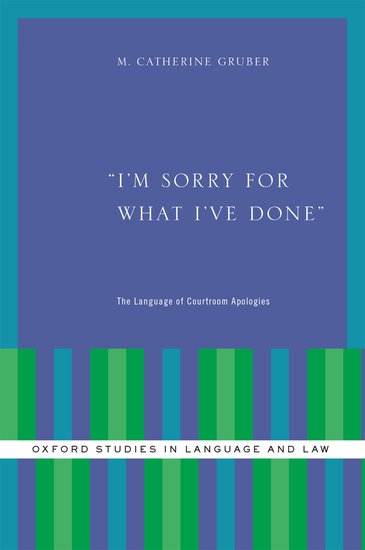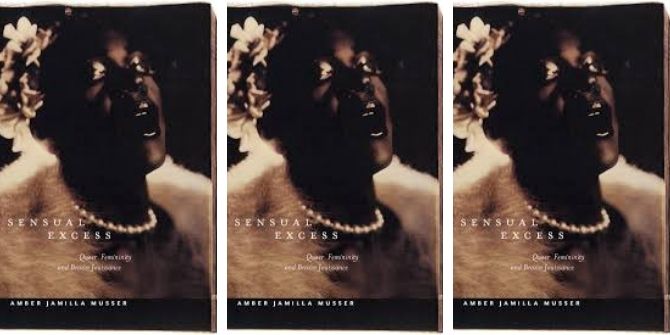
This book examines 52 apologetic allocutions produced during federal sentencing hearings, and analyses how words and phrases can influence judges and juries to be more lenient with sentencing. M. Catherine Gruber uses transcripts which include paralinguistic features such as hesitations and crying in order to analyse these interesting speech acts. Sarah Morley strongly recommends this fascinating book to readers in sociolinguistics and law.
 “I’m Sorry For What I Have Done”: The Language of Courtroom Apologies. M. Catherine Gruber. Oxford University Press. 2014.
“I’m Sorry For What I Have Done”: The Language of Courtroom Apologies. M. Catherine Gruber. Oxford University Press. 2014.
What words would you choose if you had to apologise in court for something you had done wrong? What phrasing would both effectively communicate your regret and lessons learnt? At federal sentence hearings, defendants are given the opportunity to do just that. After reading M. Catherine Gruber’s book I’m Sorry For What I Have Done, readers will come to understandthat finding the right words is much more difficult than we might first think.
Allocution –the formal statement made to the court by the defendant who has been found guilty – presents an opportunity to counter a recommendation for a sentence term made by the prosecution, by presenting oneself as remorseful and deserving of a lower sentence. Gruber’s study demonstrates that some defendants manage to do this more successfully than others. Gruber explains, for example, that although a ritualised apology formula such as “I’m sorry” would appear to be expected, its use carries implications that do not always serve the communicative goal of the defendant. Statements such as “I took money that didn’t belong to me, and I hurt people that trusted me and were my friends” seem to be a “relatively good fit for the context of allocution” (p. 6) compared to a statement like “I just wanna apologise to the court, my family, the victims and um for what I’ve done.” Defendants who made the first type of statement, Gruber explains, not only appeared sorry for their actions but also presented themselves as individuals who had a clear understanding of what they had done wrong and, as a result, were perhaps less likely to break the law in the future.
The book presents a study of fifty-two allocutions made by both male and female defendants in three US district courtrooms from a range of ages, ethnicities, and educational backgrounds. The crimes were generally non-violent and vary from bank robbery to drug related offenses to fraud. The book is exceptionally detailed, and includes all of the allocution statements in full, with a brief description of the defendant and their crime, within the index. Gruber argues that her study is distinctive for the way it intricately studies linguistic and paralinguistic features of the speech of defendants. Where we might expect to see original court transcripts, Gruber has made her own transcripts which include hesitations, false starts, and salient paralinguistic features such as audible inhalations and crying whilst talking, which are left out of standardised official transcripts. This allows her to look carefully at the variegated textures of the language used by defendants.
Apologetic allocutions constitute one of the very few opportunities for defendants to speak on their own behalf, and it is therefore important that these minutiae are not missed, as they can affect how successful the defendant’s apology can be. Linguists will recognise the influence of J.L. Austin and Erving Goffman in Gruber’s work, and interested readers might like to move to Austin’s How To Do Things With Words in particularafter finishing with Gruber, which is referenced throughout and examines speech acts more generally.

The main theme running throughout the book is that no allocutory statement is without risk. Gruber explains that there is vast potential for the defendant to minimise what they say they did. For example, in Chapter Five, “Defendants Talk about the Past, the Future, and the Present: Mitigation, Future Behaviour, and the Sentence”, it is explained that the use of the word ‘mistake’ can be extremely problematic because it can suggest that the defendant does not understand the seriousness of his or her actions, particularly when there has been a violation of federal law. Claims of having a difficult childhood offer a context in which the criminal action is more understandable; however, they differ in degree of causality. For example, they can be used as a way to communicate information about the defendant as a person rather than as a direct explanation for his or her offence. The judges within the study did respond to the information given in relation to the upbringing of the defendants, some even challenging the claims. Gruber goes on to show that explanations for offences are risky because they could be viewed as attempts to minimise the defendant’s responsibility for the offence.
Explanations also open up the defendant to criticism that similar circumstances in the future will result in similar behaviour. This is also true of any mitigating information presented, because it has the potential to subject defendants to “character-damaging implications” (p. 103). For example, one defendant stated that “[the crime was] just a matter of me. hookin up with the wrong guy at the wrong time and I didn’t – I wa-I wasn’t even with him very long, I didn’t know. his criminal background.” However, the judge noted that the defendant had been embezzling money over a “lengthy period of time”, in which the defendant was not in that relationship. Gruber explains that whilst in this particular case it was fair for the judge to point this out, a defendant’s offer of this kind of crime-related mitigating information often undermines the performance of a remorseful stance. It is therefore better for the defendant’s attorneys to be left solely with the task of communicating that their client’s crime was a one off. Gruber thus argues throughout that the various constraints imposed by the context of sentencing limits what defendants can say and how their speech is understood. It is therefore imperative to understand allocutions in order to better comprehend the criminal justice system.
I’m Sorry For What I Have Done is accessible at all levels; those who may not be familiar with allocutions or the federal legal system will be comfortable with the analysis (Chapters Two and Three are dedicated solely to these two topics), whilst those who are already acquainted with the topics should be intrigued by Gruber’s points. The book is an exceedingly interesting read in terms of what defendants actually say when they apologise and in providing Gruber’s own theories on the most effective allocutions and why the tradition of presenting allocutions may be flawed. Chapters Four and Five are particularly strong in offering the reader paralinguistic analysis and an insight into the different worlds of the people who have committed federal crimes.
Allocutions offer an insight into the speech act of making an apology, and therefore provide a valuable resource for those interested in apologies and expressive language more broadly, especially those using sociolinguistic and historical resources. Most importantly, however allocution at sentencing can have repercussions for the sentence that is imposed and therefore may be of great interest to those studying the law.
Sarah Morley graduated with a Master of Laws, with Distinction, from Durham University. She is currently a PhD Student and part-time teacher at Durham University, and was awarded the Durham Law School Scholarship. Sarah has a particular interest in Company Law and Corporate Governance. Her current research is an international study which explores the development of takeover practices and the factors that affect the takeover and corporate governance environment, including the effects of litigation. Prior to joining Durham as a PhD Student in 2013, Sarah qualified as a Welfare Rights Advisor and subsequently specialised in Money and Debt Advice. Read more reviews by Sarah.







